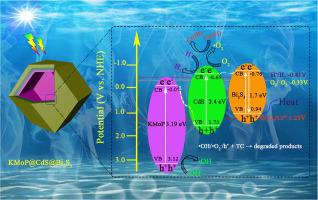Journal of Colloid and Interface Science ( IF 9.4 ) Pub Date : 2021-09-16 , DOI: 10.1016/j.jcis.2021.09.075 Yongqian Cui 1 , Zipeng Xing 1 , Meijun Guo 1 , Yalu Qiu 1 , Bin Fang 1 , Zhenzi Li 2 , Shilin Yang 1 , Wei Zhou 3

|
A hollow core–shell potassium phosphomolybdate (KMoP)@cadmium sulfide (CdS)@bismuth sulfide (Bi2S3) Z-scheme tandem heterojunction is fabricated by a simple hydrothermal strategy and kept in a water bath to continue the reaction. At the same time, the ternary structure combined Keggin-type polyoxometalate with two photosensitive sulfide semiconductors to form a stable hollow core–shell heterojunction. KMoP@CdS@Bi2S3 with a narrow band gap of ∼ 1.2 eV also has excellent photothermal performance, which may further promote photocatalytic efficiency. The hollow core–shell KMoP@CdS@Bi2S3 tandem heterojunction shows excellent H2 production performance, CrVI reduction ability and photocatalytic degradation performance of highly toxic tetracycline (TC). Under visible light irradiation, the photocatalytic H2 generation rate of the KMoP@CdS@Bi2S3 tandem heterojunction reaches 831 μmol h−1, which is 103 times higher than that of pristine KMoP. The photocatalytic reduction efficiency of CrVI and degradation efficiency of TC are as high as 95.5 and 97.51%, ∼4 times higher than that of KMoP. The boosted photocatalytic performance can be ascribed to the formation of core–shell Z-scheme tandem heterojunctions favoring spatial charge separation and the narrow band gap, which extends the photoresponse to visible light/NIR regions. When TC and CrVI exist at the same time, the reduction efficiency of CrVI can be as high as 99.64% because the intermediate of TC degradation can promote the reduction of CrVI. In addition, the photocatalytic performance of the KMoP@CdS@Bi2S3 heterojunction remains nearly constant after 4 recycles, which indicates high stability. The design strategy may provide new insights for preparing other high-performance core–shell tandem heterojunction photocatalysts for solar energy conversion.
中文翻译:

空心核壳磷钼酸钾@硫化镉@硫化铋Z-Scheme串联异质结优化光热-光催化性能
空心核壳磷钼酸钾(KMoP)@硫化镉(CdS)@硫化铋(Bi 2 S 3)Z型串联异质结是通过简单的水热策略制造的,并保持在水浴中以继续反应。同时,三元结构将 Keggin 型多金属氧酸盐与两种光敏硫化物半导体结合,形成稳定的空心核壳异质结。KMoP@CdS@Bi 2 S 3具有~1.2 eV的窄带隙也具有优异的光热性能,可以进一步提高光催化效率。空心核壳 KMoP@CdS@Bi 2 S 3串联异质结显示出优异的 H 2生产性能,Cr剧毒四环素(TC)的VI还原能力和光催化降解性能。在可见光照射下,KMoP@CdS@Bi 2 S 3串联异质结的光催化H 2生成率达到831 μmol h -1,是原始KMoP的103倍。Cr VI的光催化还原效率和 TC 的降解效率分别高达 95.5% 和 97.51%,是 KMoP 的 4 倍。光催化性能的提高可归因于核壳 Z 型串联异质结的形成,有利于空间电荷分离和窄带隙,将光响应扩展到可见光/近红外区域。当 TC 和 CrVI同时存在,Cr的还原效率VI可高达99.64%,因为中间TC降解的可促进Cr的还原VI。此外,KMoP@CdS@Bi 2 S 3异质结的光催化性能在4次循环后几乎保持不变,表明其具有高稳定性。该设计策略可能为制备用于太阳能转换的其他高性能核壳串联异质结光催化剂提供新的见解。











































 京公网安备 11010802027423号
京公网安备 11010802027423号